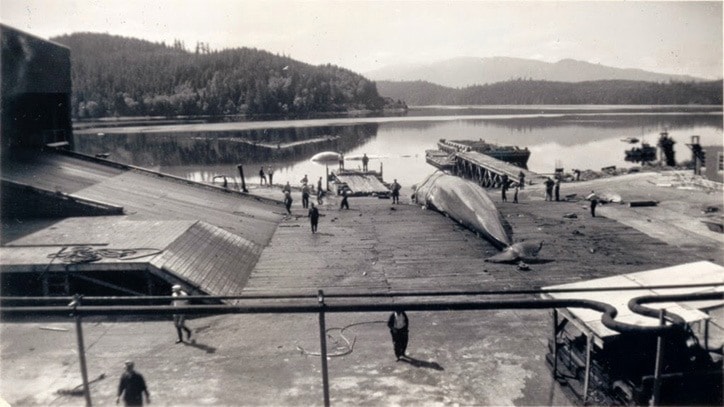In the mid-1800s the whaling industry was in its heyday on the Pacific Coast, until the lucrative right whales were hunted almost to extinction. It is estimated that the Northern Pacific right whale catches between 1840 and 1849 could have been as high as 30,000 individuals. As the availability of these ceatations declined, the fleet turned to the more lucrative fur seal harvest for a number of years.
Many BC First Nations people were recruited to work on whaling vessels, which would travel all over the Pacific Ocean. Some early settlers were surprised to enter a First Nations’ big house in Quatsino in the mid-1800s to find First Nations women wearing traditional kimonos. These had been obtained through men working on whaling ships which visited Japan.
In the early part of the 20th century there was a revival of interest in whaling. Whaling stations were built along the BC coast at Sechart (Port Alberni), Cachalot (Kyoquot), Naden Harbour (Haida Gwaii), and Rose Harbour (Haida Gwaii). The whaling industry existed largely to provide oil and fertilizer, and was heavily reliant on Norwegian expertise. A recession, coupled with a glut of whale oil on the international market, resulted in the closure of most BC whaling stations in the early 1920s.
With the advent of World War II, and the internment of Japanese Canadians, the BC whaling industry lost much of its shore-based labour force. Production came to a halt for a few years and faced significant restructuring. The prohibition on civilians using marine radios during the war years also made it difficult, if not impossible, to carry out whaling on the Pacific Coast.
In 1948 a new “Canadian-owned” whaling corporation was formed: the Western Whaling Company.
Initially the consortium intended to retrofit the old Rose Harbour Whaling Station on Haida Gwaii, but about this time the Canadian government divested a seaplane base it had constructed for WWII in Coal Harbour, Quatsino Sound.
The site had two large hangars with big bay doors, docks, accommodation, and a sloped ramp for loading sea planes in and out of the water. The Western Whaling Company snapped up the site and fitted it with digesters, cookers, a meat press, separators, an evaporator and freezer plant.
The largest disadvantage of the site was its distance from the whaling grounds, but an arrangement was made to have harvest vessels tow their whales into Winter Harbour, where transport vessels could pick them up and tow them in to the Coal Harbour processing facility.
Compared to earlier whaling efforts, this era saw larger boats, improved technology (including the use of airplanes to find whales), and a longer hunting season.
In its first season, 1948, the station processed 182 whales.
The main products were oil and tinned meat, which was in high demand during the war. The next year production increased to 250 whales.
(Brenda McCorquodale is a Port Hardy resident and North Island history enthusiast. If you have any stories or local lore you’d like to share, email her at storeysbeach@gmail.com. A collection of her past articles is available on her blog at undiscoveredcoast.blogspot.ca/.)
